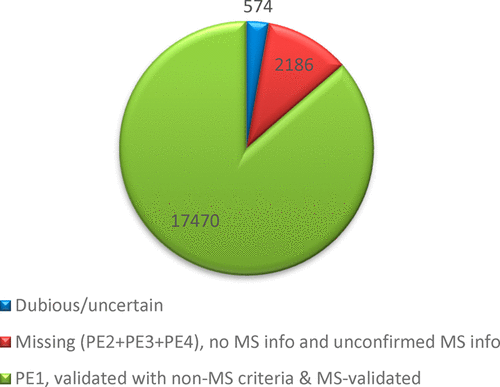当前位置:
X-MOL 学术
›
J. Proteome Res.
›
论文详情
Our official English website, www.x-mol.net, welcomes your
feedback! (Note: you will need to create a separate account there.)
Progress on Identifying and Characterizing the Human Proteome: 2018 Metrics from the HUPO Human Proteome Project
Journal of Proteome Research ( IF 3.8 ) Pub Date : 2018-08-23 , DOI: 10.1021/acs.jproteome.8b00441 Gilbert S Omenn 1, 2 , Lydie Lane 3 , Christopher M Overall 4 , Fernando J Corrales 5 , Jochen M Schwenk 6 , Young-Ki Paik 7 , Jennifer E Van Eyk 8 , Siqi Liu 9 , Michael Snyder 10 , Mark S Baker 11 , Eric W Deutsch 2
Journal of Proteome Research ( IF 3.8 ) Pub Date : 2018-08-23 , DOI: 10.1021/acs.jproteome.8b00441 Gilbert S Omenn 1, 2 , Lydie Lane 3 , Christopher M Overall 4 , Fernando J Corrales 5 , Jochen M Schwenk 6 , Young-Ki Paik 7 , Jennifer E Van Eyk 8 , Siqi Liu 9 , Michael Snyder 10 , Mark S Baker 11 , Eric W Deutsch 2
Affiliation

|
The Human Proteome Project (HPP) annually reports on progress throughout the field in credibly identifying and characterizing the human protein parts list and making proteomics an integral part of multiomics studies in medicine and the life sciences. NeXtProt release 2018–01–17, the baseline for this sixth annual HPP special issue of the Journal of Proteome Research, contains 17 470 PE1 proteins, 89% of all neXtProt predicted PE1–4 proteins, up from 17 008 in release 2017–01–23 and 13 975 in release 2012–02–24. Conversely, the number of neXtProt PE2,3,4 missing proteins has been reduced from 2949 to 2579 to 2186 over the past two years. Of the PE1 proteins, 16 092 are based on mass spectrometry results, and 1378 on other kinds of protein studies, notably protein–protein interaction findings. PeptideAtlas has 15 798 canonical proteins, up 625 over the past year, including 269 from SUMOylation studies. The largest reason for missing proteins is low abundance. Meanwhile, the Human Protein Atlas has released its Cell Atlas, Pathology Atlas, and updated Tissue Atlas, and is applying recommendations from the International Working Group on Antibody Validation. Finally, there is progress using the quantitative multiplex organ-specific popular proteins targeted proteomics approach in various disease categories.
中文翻译:

人类蛋白质组识别和表征的进展:HUPO 人类蛋白质组项目 2018 年指标
人类蛋白质组项目 (HPP) 每年报告整个领域在可靠地识别和表征人类蛋白质部分列表以及使蛋白质组学成为医学和生命科学多组学研究不可或缺的一部分方面的进展。 NeXtProt 2018-01-17 版是《蛋白质组研究杂志》第六届年度 HPP 特刊的基线,包含 17 470 个 PE1 蛋白,占所有 neXtProt 预测的 PE1-4 蛋白的 89%,高于 2017-01 版的 17 008 个2012 年 2 月 24 日发布的 –23 和 13 975。相反,neXtProt PE2,3,4 缺失蛋白的数量在过去两年中从 2949 个减少到 2579 个,再减少到 2186 个。在 PE1 蛋白中,16 092 个基于质谱结果,1378 个基于其他类型的蛋白质研究,特别是蛋白质-蛋白质相互作用的发现。 PeptideAtlas 拥有 15,798 个典型蛋白质,比去年增加了 625 个,其中包括来自 SUMOylation 研究的 269 个。蛋白质缺失的最大原因是丰度低。与此同时,人类蛋白质图谱发布了细胞图谱、病理学图谱和更新的组织图谱,并正在应用国际抗体验证工作组的建议。最后,在各种疾病类别中使用定量多重器官特异性流行蛋白靶向蛋白质组学方法取得了进展。
更新日期:2018-11-29
中文翻译:

人类蛋白质组识别和表征的进展:HUPO 人类蛋白质组项目 2018 年指标
人类蛋白质组项目 (HPP) 每年报告整个领域在可靠地识别和表征人类蛋白质部分列表以及使蛋白质组学成为医学和生命科学多组学研究不可或缺的一部分方面的进展。 NeXtProt 2018-01-17 版是《蛋白质组研究杂志》第六届年度 HPP 特刊的基线,包含 17 470 个 PE1 蛋白,占所有 neXtProt 预测的 PE1-4 蛋白的 89%,高于 2017-01 版的 17 008 个2012 年 2 月 24 日发布的 –23 和 13 975。相反,neXtProt PE2,3,4 缺失蛋白的数量在过去两年中从 2949 个减少到 2579 个,再减少到 2186 个。在 PE1 蛋白中,16 092 个基于质谱结果,1378 个基于其他类型的蛋白质研究,特别是蛋白质-蛋白质相互作用的发现。 PeptideAtlas 拥有 15,798 个典型蛋白质,比去年增加了 625 个,其中包括来自 SUMOylation 研究的 269 个。蛋白质缺失的最大原因是丰度低。与此同时,人类蛋白质图谱发布了细胞图谱、病理学图谱和更新的组织图谱,并正在应用国际抗体验证工作组的建议。最后,在各种疾病类别中使用定量多重器官特异性流行蛋白靶向蛋白质组学方法取得了进展。











































 京公网安备 11010802027423号
京公网安备 11010802027423号